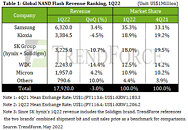
WD Plans to Muscle in on Xbox Series X|S Storage Expansion Card Scene
It appears that Western Digital is readying its own line of Xbox Series X|S Storage Expansion cards, and undercutting its big rival - Seagate - in a currently exclusive storage solution market. Word spread across several gaming communities over the past weekend about a new listing on Best Buy, now removed as of late April 2, for a 1 TB capacity WD_BLACK C50 Expansion Card with an asking price of $179.99. WD has offered official external storage solutions for the current generation of Xbox home games consoles, under its WD_BLACK range, but Microsoft granted exclusive manufacturing rights to Seagate for the proprietary Xbox Series X|S storage expansion card system. According to official site information and documentation, these expansion cards are effective in "delivering additional external memory while maintaining the same peak speed and performance as the console's internal SSD".
The Seagate range could have been a timed exclusive, and based on the now deleted Best Buy listing, Microsoft seems to have handed a license to WD. The 1 TB WD_BLACK C50 Expansion Card's pricing was a big talking point, due to it being substantially cheaper than the equivalent capacity Seagate model ($219.99) - a saving of forty dollars, which is an encouraging sign for gamers who have long complained that the Xbox proprietary expansion card offers bad value for money. Seagate's current crop of cards start at $139.99 (512 GB) and go up to $399.99 (2 TB).
The Seagate range could have been a timed exclusive, and based on the now deleted Best Buy listing, Microsoft seems to have handed a license to WD. The 1 TB WD_BLACK C50 Expansion Card's pricing was a big talking point, due to it being substantially cheaper than the equivalent capacity Seagate model ($219.99) - a saving of forty dollars, which is an encouraging sign for gamers who have long complained that the Xbox proprietary expansion card offers bad value for money. Seagate's current crop of cards start at $139.99 (512 GB) and go up to $399.99 (2 TB).
















































